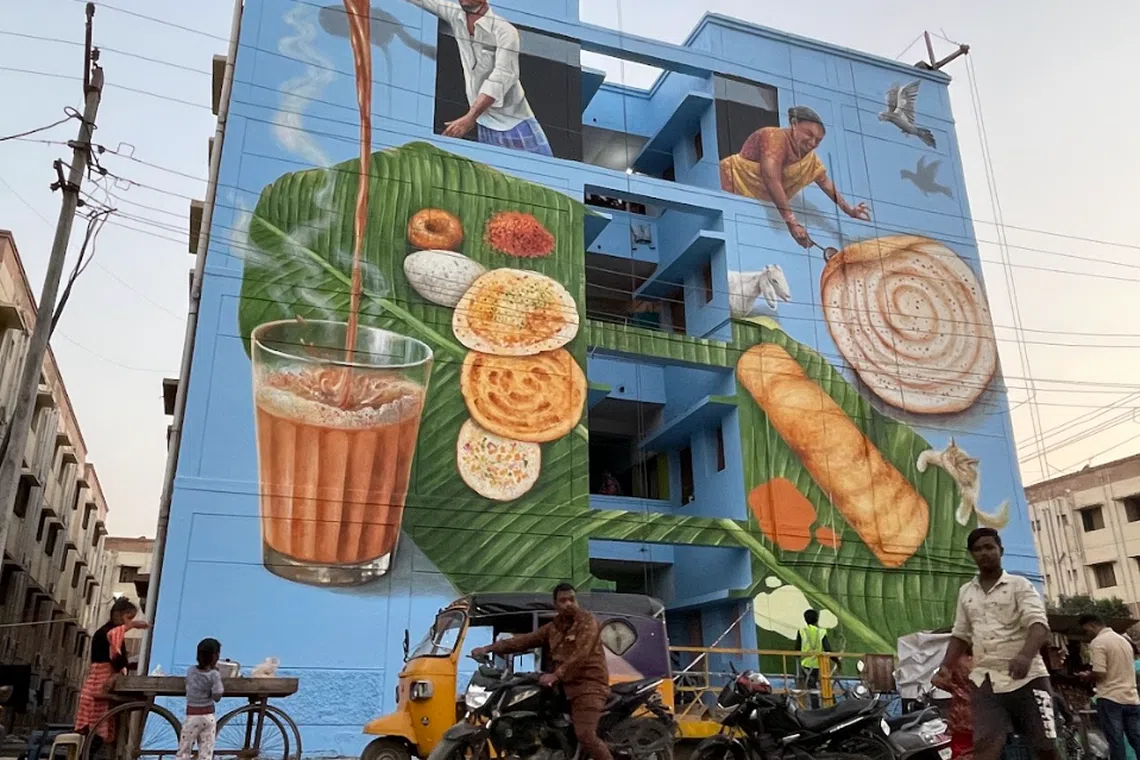S’porean artist Yip Yew Chong’s giant mural in Tamil Nadu city captures scenes of everyday life
Sign up now: Get ST's newsletters delivered to your inbox

The 15m by 14m mural on the side of a residential building in Ukkadam featuring images of daily life there, such as a woman making thosai.
PHOTO: COURTESY OF YIP YEW CHONG
Follow topic:
SINGAPORE – When Singaporean artist Yip Yew Chong got a call asking him to go to a city in the south Indian state of Tamil Nadu and adorn its walls with his colourful murals, he jumped at the chance.
Years ago, Mr Yip, 55, who is known for large murals depicting everyday life
But he had never been to the southern state of Tamil Nadu, where many Indian Singaporeans trace their roots to.
He said: “The Coimbatore trip is my first to Tamil Nadu. Actually, I feel like finally, I get to see the ancestral place of many of my fellow Singaporean and Malaysian Tamil friends.”
Coimbatore is the second-largest city in Tamil Nadu and is about 500km from the capital Chennai.
During his 1½ weeks in Coimbatore from the end of January, Mr Yip focused on painting a single mural on the walls of a residential building in a town called Ukkadam.
Measuring 15m by 14m, it features images of daily life, such as a drinks seller pouring tea and a woman making the rice and lentil pancake thosai. Mr Yip said he drew inspiration from what he saw around him.
“Every evening, a pani puri pushcart stall would come and park right in front of the mural. I decided to add him to the mural as a life-size part of the giant painting.” Pani puri is a popular Indian street snack featuring crispy, hollow, fried dough balls stuffed with savoury boiled potatoes and lentils.
He also decided to add in Tamil the phrase, “Come, let’s eat”, a nod to the many advertisements he saw on the walls of the city. He got the help of a typographer to make sure he got the words right.

Mr Yip’s mural incorporating a life-sized image of a real pani puri seller who parked his pushcart stall in front of the giant painting every evening.
PHOTO: COURTESY OF YIP YEW CHONG
Mr Yip also said he enjoyed talking to people, often with the help of translators and the “universal language of art”. “I added a goat and a cat to the mural because the residents kept asking me to paint their pets and animals.”
Sometimes, he got a little help from passers-by.
“There was this man who corrected the shape of the spatula used to make thosai in my mural. He took my brush and drew the correct shape on the ground.”

Mr Yip had immersed himself in the culinary delights Coimbatore had to offer, like thosai and other specialities, which were served on banana leaves.
PHOTO: COURTESY OF YIP YEW CHONG
In Singapore, Mr Yip’s murals are popular with people active on social media platforms such as Instagram and TikTok who use them as backdrops for their video clips, adding a touch of colour and some local flavour to their online content.
Mr Yip, who was an accountant before he became a full-time artist some time in 2018, was invited to India by the St+art India Foundation, to take part in the Ukkadam Mural Festival.
In response to queries, the St+art India Foundation, a not-for-profit arts group, said it is “open to the possibility of future collaborations with Mr Yip, exploring projects that resonate with the artistic vision and ethos shared by both”.
In 2019, the foundation invited him to paint murals in the Lodhi Art District, in the Indian capital New Delhi.
“After 25 years in finance, it is about time to develop my passion for art,” Mr Yip said, now that his children are grown up and the timing felt right.

Mr Yip said he enjoyed talking to people, often with the help of translators and the “universal language of art”.
PHOTO: COURTESY OF YIP YEW CHONG
In 2023, Mr Yip put on display for the first time a complete 60m-long painting comprising 27 panels of his impressions of Singapore in the 1970s and 1980s
During his stay in Coimbatore, Mr Yip immersed himself in the culinary delights the city had to offer, such as thosai and other Indian specialities, which were always served on banana leaves.
He said: “There are similarities with Singaporean and Malaysian Tamil culture such as Thaipusam, roti prata and teh tarik, but it’s quite amazing to see how culture has evolved among the diaspora.”


